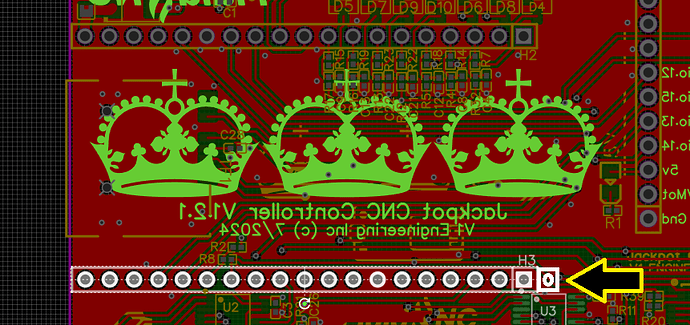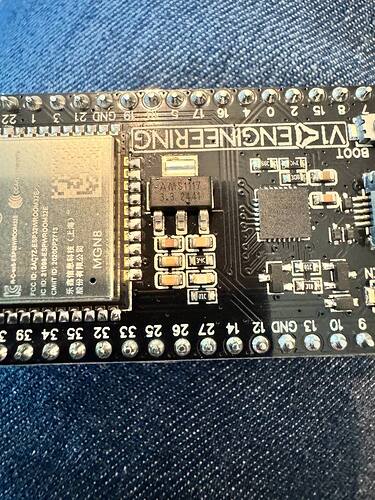I described this before, but maybe the picture below helps. Put an extension on the Jackpot PCB near the SD card slot. Populate two pins that are electrically no connect, but which would mechanically exclude the antenna being put there.
Given…
I didn’t respond to…
Could edit Jackpot’s H3 header to 20 pin, and, update V1E ESP32 with similar change? This isn’t a breaking change, and would be backward compatible.
However newly modified V1E ESP32 modules would have a pin floating if used with older (existing) JackPot boards, not sure if PCB folks here think that’s acceptable or atrocious?
Would that asymmetrical layout will provide a enough of a cue to people to minimize future instances?
Would the design still be similar enough that either the JackPot and/or the ESP32 board are compatible with other regular 2 x 19 hardware too?
Maybe change H3 header to 20 Pin by simply adding extra GND. Need to move some near by traces. Or, instead of another GND, could use this as an opportunity to breakout an extra IO pin ![]() .
.
People wanting to use the V1E ESP32 in other situations can clip the extra GND pin if needed to fit their 2x19pin projects.
This doesn’t help people using 3rd party ESP32 modules. This only helps people using V1E ESP32 with JackPot.
There’s a mechanical interfering option that doesn’t need a nonstandard ESP-32 literally one post above yours… ![]()
Yep, wasn’t sure how that would work with the SD Card (currently) being so close. SD card is pretty hard to access as-is, if anything, would be nice if the SD card holder was floating over edge of the JackPot board for easier access when controller is in a printed enclosure.
So, are you thinking the antenna reject/blocking pins, and nudging the SD Card out on the board extension would help? SD Card doesn’t have to be symmetrically placed (relative to the ESP32) if that makes room for at least one reject pin? Am looking at a spare JackPot and SD Card slot, I don’t see how you fit a pin above and below in sketch from your earlier post.
Move the SD card back so it’s out to the edge of the little red extension of the board. Long pins go on either side of the SD card shell, which would interfere with the antenna if you tried to install it the wrong way round, but not if you installed it properly. Would not interfere with the SD card at all.
Or, I offer a built-in solution. We might be nearing a place now that I can offer both. Keep the same footprint and locations for most things. I am learning a lot, I know I can cram both designs together at this point and lower the cost as well. This is something I plan on looking into when the LR4 dust settles and the firmware and configs have been reworked, heck and the instructions a bit.
There’s a possiblity for some special add-ons too. Like the combo RS-485/Pendant adapter that may work on a Jackpot because there are 4 unique GPIOs exposed on the expansion connector.
Also, isn’t the -S3 version of the ESP-32 available in a flavor with more GPIOs? That would be interesting as well.
More GPIOs, and the ability to have MBs of RAM.
It is not officially supported by FluidNC though, and not on their radar any time soon, although Bar and another FluidNC developer have been playing with it with some success
Mitch has recently made more favorable comments around the S3.
Perhaps it may become more of a reality at some point
I’ve been having this one sitting in my Amazon cart for a while considering playing with it, but haven’t pulled the trigger yet…
Can we also look at the possibility of adding 24v headers for things like the Fans and LEDs? Honestly just one would work for both of those.
Personally like being able to insert my own module if/when overly frustrated with PCB antenna, and switch to module with external antenna.
Is it too soon to start a thread “Brainstorming for the next V1 FluidNC controller”?
It might not be a jackpot, or perhaps there’s a low end- and a high-end.
The extra GPIO from the S3 would be nice, as would the extra memory.
Fan headers or other IO.
Maybe two expansion slots.
I suspect we’ll see additional FluidDial type controlls using a larger screen or maybe even an app that emulates the FluidDial interface on a larger screen.
Keying so you can’t muck up your dev board inserting it wrong.
Edit- that S3 module has both USB guest and USB host connectors? That would be interesting.
For me, having a removable ESP32 is very convenient since my PC and LR3 aren’t next to each other. I also like being able to try things on a spare ESP32 so I don’t mess with a known good configuration. I am intrigued by the S3 but it doesn’t seem like a good mainstream choice unless it becomes officially supported. It’s not clear when/if that might happen.
And, who’s said that all the time that it would be neat? ![]()
I just talked to Bar about it today. He was at a local makerfaire. It got a little busy so I will ask him more about it another time.
Throwing this out if there is a Jackpot II, and/or support for the bigger -S3 variant.
Add ESD protection diodes to the GPIOs on the expansion connector.
I’m stupid.
I just cooked it myself
inverted mount
Sorry Bryan I didn’t see the figure on the Jackpot
![]()
![]()
![]()
Yeh, done that. Maybe we should get some sort of special ‘ goof’ forum achievement ![]()
Hmm I just found some of those regulators in my collection of random components. Maybe I should give that a shot.


